Dell U3011 Review: Dell's New 30-inch Flagship
by Brian Klug on January 13, 2011 9:17 PM ESTViewing Angles
The U3011 has superb viewing angles, just like we've grown accustomed to seeing from IPS panels. Even at the far extreme horizontally, there's none of the purple I'm used to seeing from TN panels as you move off-axis. In the vertical direction, I saw the same thing with almost nothing to complain about. I did notice some glare at the extreme angles, but again that's dependent on where you're sitting and where light sources are located.
I think this is an excellent opportunity to talk about IPS graininess, something we really haven't discussed before. Of the IPS panels I've used to date, all of them have had some high frequency grain on the surface from a combination of coating and interference at the interface. Thankfully the U3011 has a combination antireflection coating and hard coating, and subjectively there seems to be less grain than I've seen on other displays.
Color Quality
Next up are the ever-important color quality metrics. As usual, we report two main quality metrics: color accuracy (Delta-E) and color gamut. Color gamut refers to the range of colors the display is able to represent with respect to some color space. In this case, our reference is the AdobeRGB 1998 color space, which is larger than the sRGB color space. Our percentages are thus reported with respect to AdobeRGB 1998, and larger is generally better unless you're dealing with sRGB content and colorspace-unaware software.
Color accuracy (Delta E) refers to the display’s ability to display the correct color requested by the GPU and OS. The difference between the color represented by the display, and the color requested by the GPU is our Delta-E, and lower is better here. In practice, a Delta E under 1.0 is perfect - the chromatic sensitivity of the human eye is not great enough to distinguish a difference. Moving up, a Delta E of 2.0 or less is generally considered fit for use in a professional imaging environment - it isn’t perfect, but it’s hard to gauge the difference. Finally, Delta E of 4.0 and above is considered visible with the human eye. Of course, the big consideration here is frame of reference; unless you have another monitor or some print samples like a Gretag Macbeth color checker card to compare your display with, you might not notice.
As I mentioned in our earlier reviews, we’ve updated our display test bench. We’ve deprecated the Monaco Optix XR Pro colorimeter in favor of an Xrite i1D2 since there are no longer up-to-date drivers for modern platforms. We're trying to find an i1Pro to use as well.
For these tests, we calibrate the display and try to obtain the best Delta-E we can get at both 200 nits of brightness for normal use, and 100 nits for print brightness. We target D65 and a gamma of 2.2, but sometimes the best performance lies at native temperature and another gamma, so we try to find what absolute absolute best-case performance for each display. We also take an uncalibrated measurement to show performance out of the box using either the manufacturer supplied color profile, or a generic one with no LUT data. For all of these, dynamic contrast is disabled, and displays are left to settle for a half hour after making changes. The U3011 is CCFL-backlit, and I used a settle time of 30 minutes accordingly.
First up is uncalibrated Delta-E performance. For this test, I took the monitor out of the box, connected it over DisplayPort, adjusted to 200 nits, and ran our usual GMB color checker test. Results aren't that great, sadly.
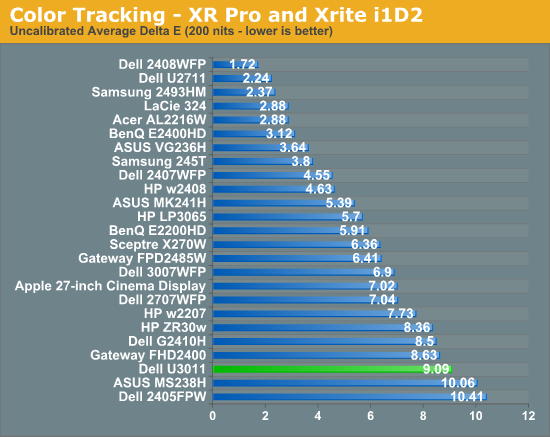
I mentioned earlier that the U3011 we got from Dell for testing came with no factory calibration report. After checking up with them, we learned this is a pre-production unit identical to what's shipping now, minus that factory calibration. That's something we can live with, especially since we recommend every display be calibrated, but still unnerving.
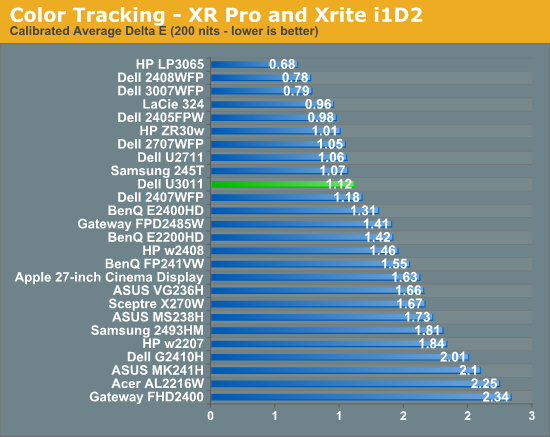
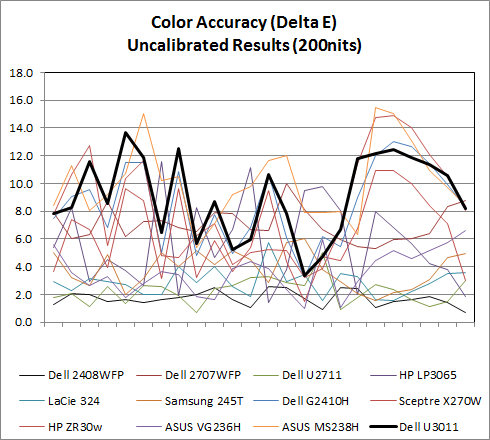
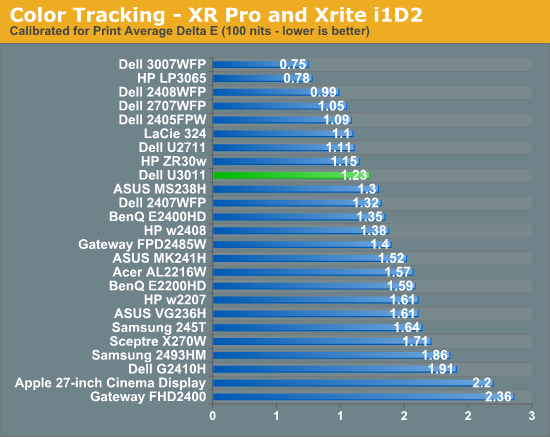
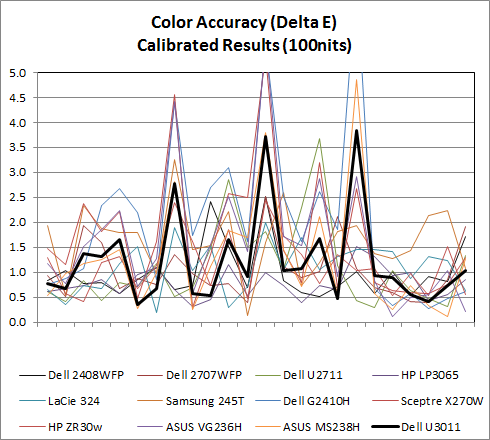
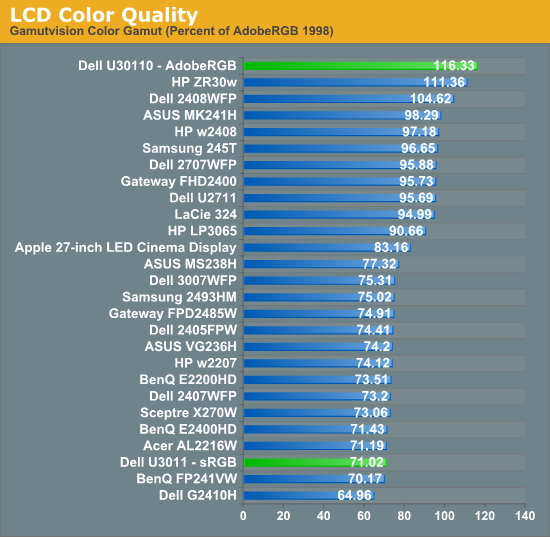

AdobeRGB Mode
sRGB Mode
Calibrated Delta-E is very good, though I'm still surprised the U3011 can't get under 1.0 on our tests. I'm starting to suspect that our i1D2 isn't quite as good as the Monaco Optix XR Pro, and have started looking for an i1Pro spectroradiometer as a result so we can have something more accurate going forward. That said, performance is still more than adequate for professional work. These two calibrations were performed in the sRGB mode at D65.
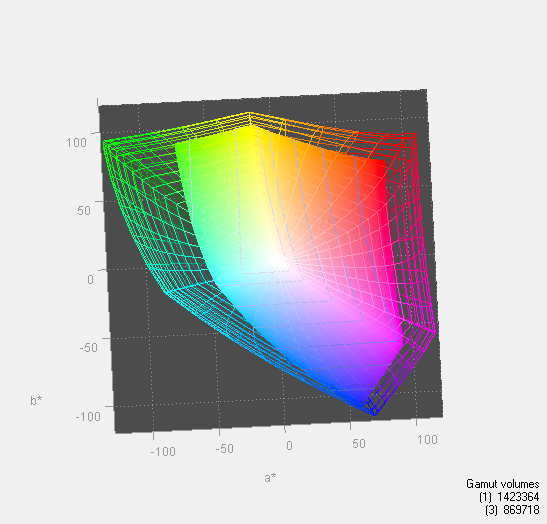
In addition, the U3011 has modes for AdobeRGB color space and sRGB in the OSD, something extremely useful for doing work and not getting oversaturation in applications that lack color management. You can immediately see the effect of those two modes in the color gamut measure above. Letting the monitor free to use its entire gamut of color, it leads the pack. Turn sRGB mode on, and it clamps down just nicely. 116.33% is also shockingly close to Dell's advertised 117% coverage of CIE 1796 (AdobeRGB), which is awesome to see confirmed above.








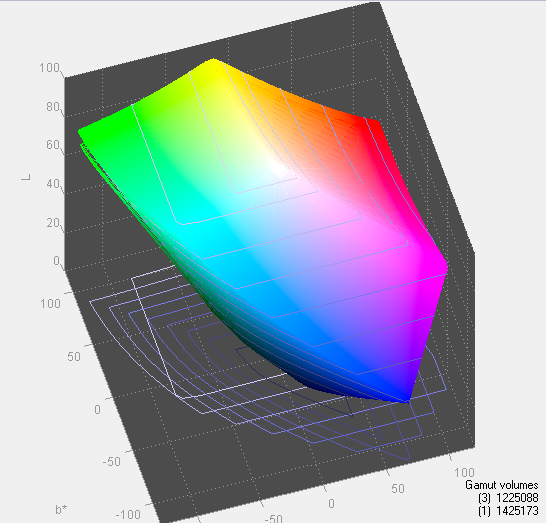
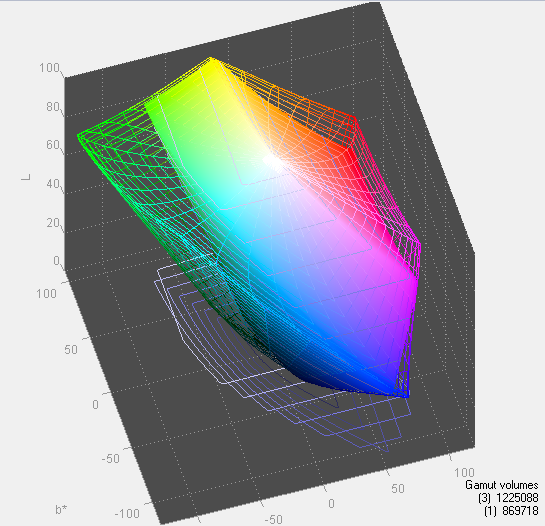








123 Comments
View All Comments
CSMR - Friday, January 14, 2011 - link
High pixel pitch will increase legibility of text, and everything vector-based.Guspaz - Friday, January 14, 2011 - link
In terms of pricing from Dell themselves, I'm seeing the U2711 at $849 CAD, and the U3011 at $1599 CAD. Considering they offer the same class of resolution (2560xSomething, although I'd rather see 2560x1600 on the U2711, at least it's still 2560), a similar set of inputs, and the U2711 is a bit better in calibrated colour accuracy (and way better uncalibrated), it really looks to me like the U2711 is the better buy.Sabresiberian - Friday, January 14, 2011 - link
Same class of resolution? The pixel pitch on the 30" is .2505, the pixel pitch on the 27" is .233 - clearly a much tighter image. They aren't in the same resolution class by a long shot.I agree, I'd love to see a 2560x1600 .233 pixel pitch monitor - or better yet, a full 30",16:10 monitor with that pixel pitch. That would make my current 3-way conundrum - buy a U2711, a ZR30w, or wait for that 120Hz 30" monitor, a much easier decision. Especially if it were 120Hz. The dang 16:9 ratio of the U2711 is what makes it such a tough choice; I just don't want to support the industry using that format in any way - but I do want to throw in my vote for small pixel pitch as well as use a monitor with as fine a screen as I can get.
;)
Iketh - Saturday, January 15, 2011 - link
How are you supposed to get 2560x1600 .233 pitch on a 30" screen? That's physically impossible. May want to read up on what pixel pitch is, and the reason why a smaller screen with the same resolution will always have a lower pitch.adiposity - Sunday, January 16, 2011 - link
If you read his comment carefully, he didn't say that. He said either:a 2560x1600 @.233 pitch
or
a 30" 16:10 monitor with .233 pitch
Hrel - Friday, January 14, 2011 - link
Dang, look at those response times! No guitar hero being played on this thing.AnnonymousCoward - Saturday, January 15, 2011 - link
7ms GTG. How often does a PS3 refresh frames--24fps? That's 42ms.I'll give you the benefit of the doubt and assume you only play Guitar Hero on PC emulators with a CRT @ >140Hz.
aguilpa1 - Friday, January 14, 2011 - link
the OSD is the same as the Alienware 23" 120Hz LCD's, even copied the light up touch panel but went with blue instead of red. They may have considered the 120Hz option. Also the Optx 2310's have panel overdrive which mitigates the response time and removes the lag. I noticed on some reviews of the 2310's they are not doing this and reporting the panels have to much lag especially in 3D mode but if you set the panels to game mode and enable overdrive the visible lag problem goes away. I did that to all three of mine.MeanBruce - Friday, January 14, 2011 - link
Dude, It's the same OSD because Dell bought Alienware a few years back. Same design group. Pretty sure all the 24in panels Dell/Alienware are assembled in the same little factory in Meheeco.aguilpa1 - Friday, January 14, 2011 - link
yup I know this, I was just saying, when I ordered my three 2310's they were from Dell. On a panel that is supposed to be their flagship they should have also stole the quality of design, the 120Hz, the overdrive engine and not just the OSD from the 2310's.